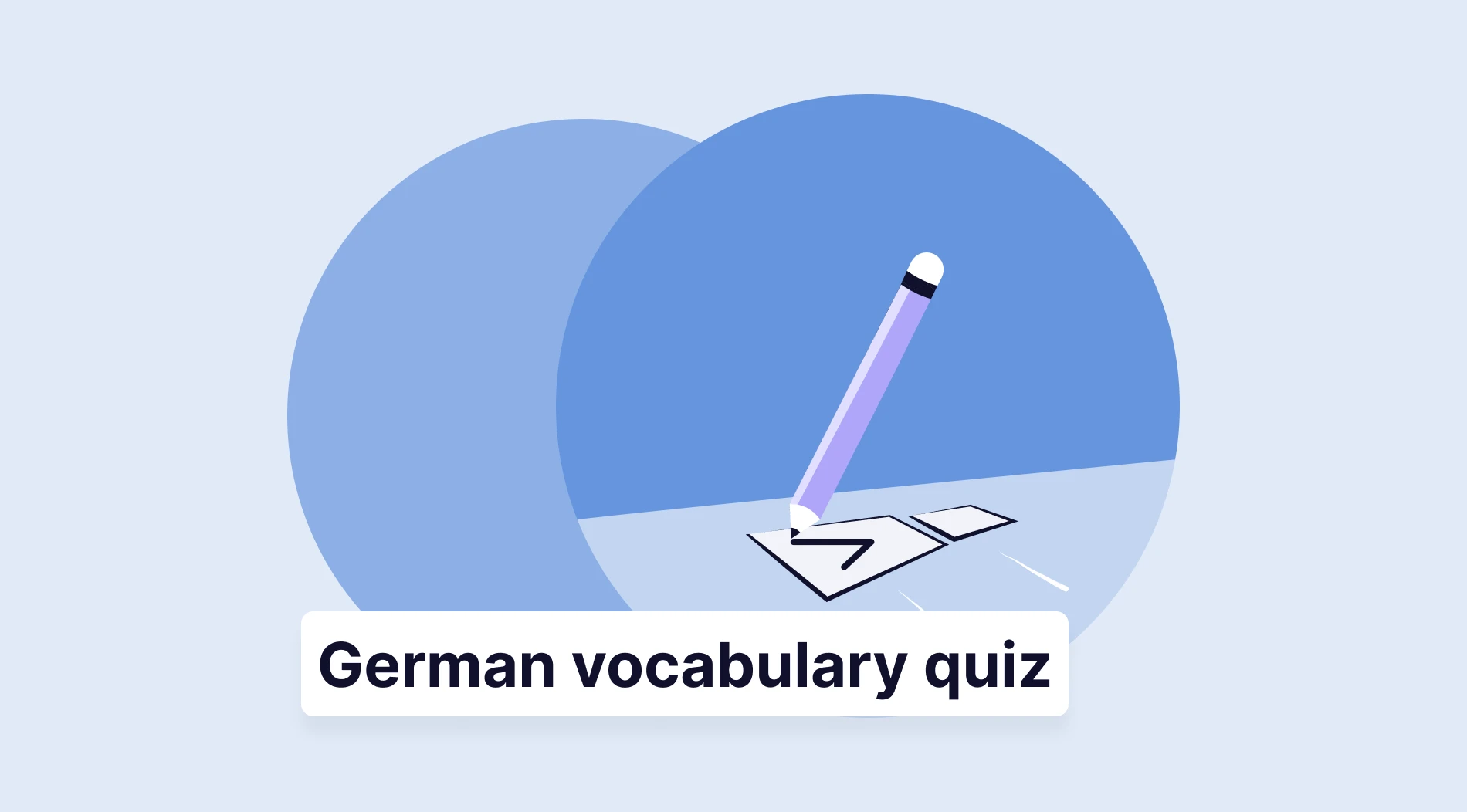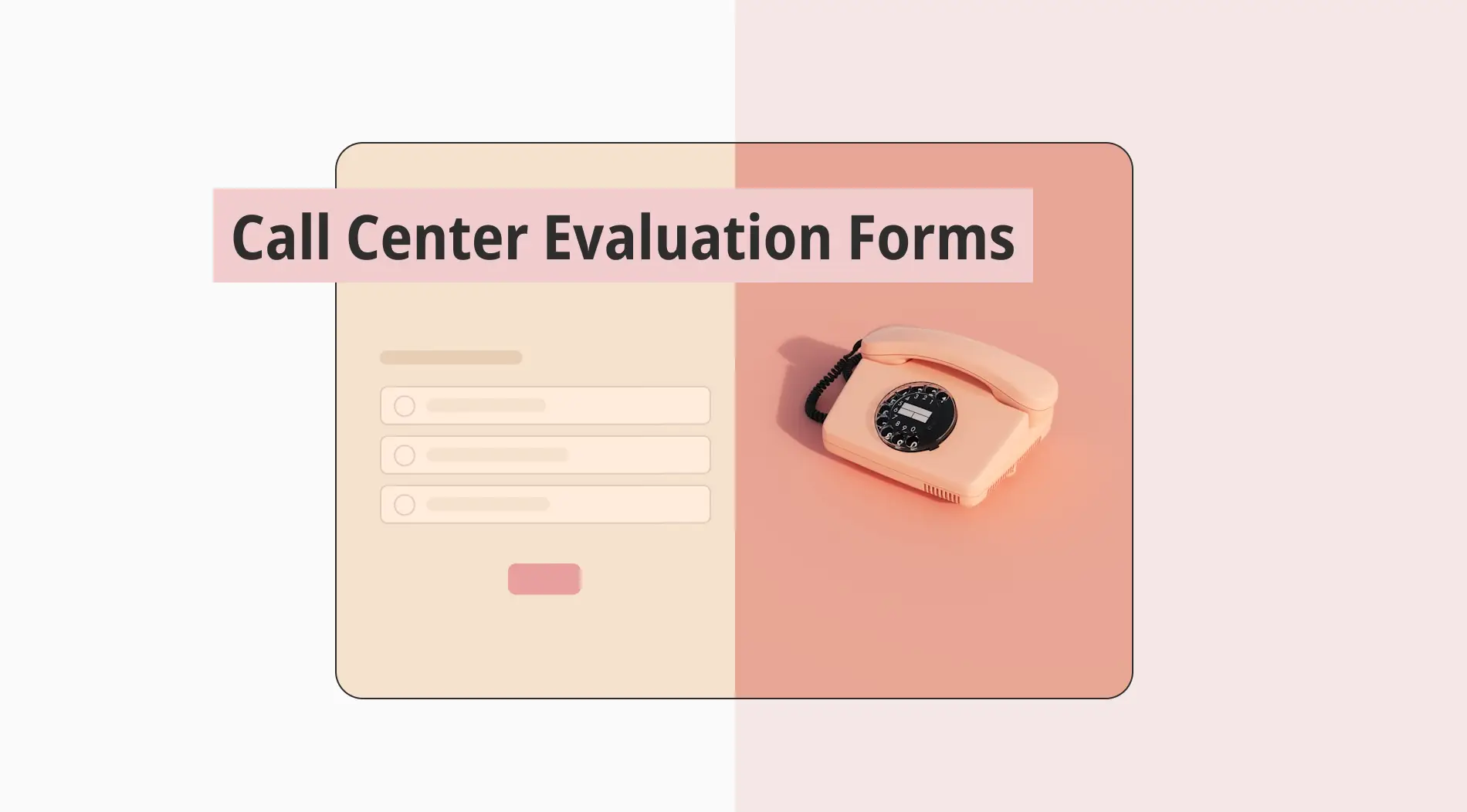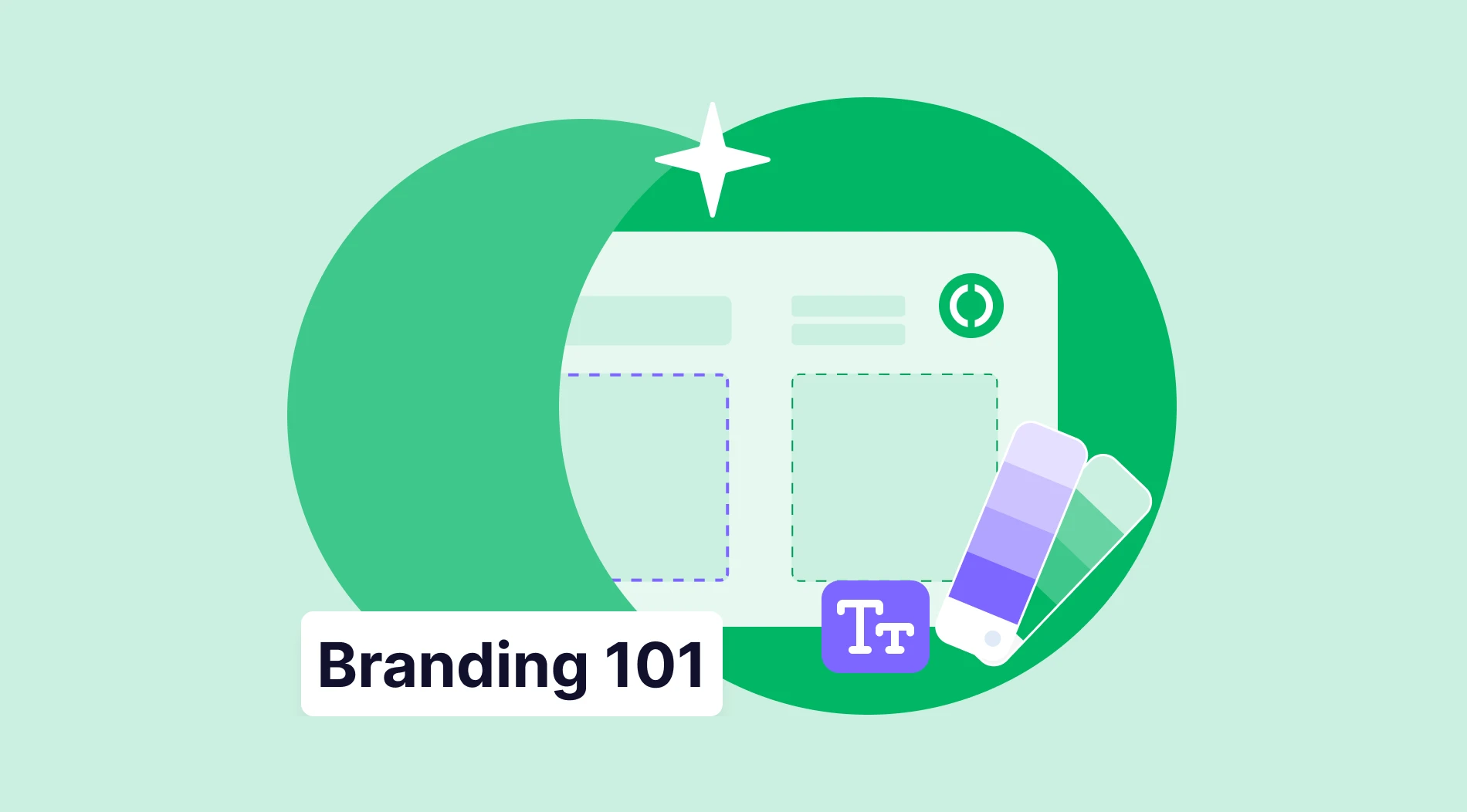Every company that wishes to grow in the business world knows that sometimes you need to take risks to stay in the game and expand strongly. Companies that want to keep their businesses in the long run focus on setting visionary, long-term elements leading up to achieving their target.
BHAG - Big Hairy Audacious Goal - is to help you ultimately accomplish these plans you have been working on in your business. In this article, we have covered the meaning of BHAG, the importance of BHAG, types of BHAG, examples of well-known successful BHAGs, examples of BHAG goals, and tips to have better BHAGs for the future of your business. Let’s dive in!
What is BHAG?
Big Hairy Audacious Goal (BHAG - pronounced “bee hag”) is a clear and achievable goal that a business sets for long-term success.
It is a concept that focuses on ambitious and compelling goals with effort and persistence that require stepping out of one’s comfort zone. This inspirational term was initially introduced by Jim Collins and Jerry Porras in 1994 in their book Built to Last: Successful Habits of Visionary Companies.”
Benefits of the BHAG
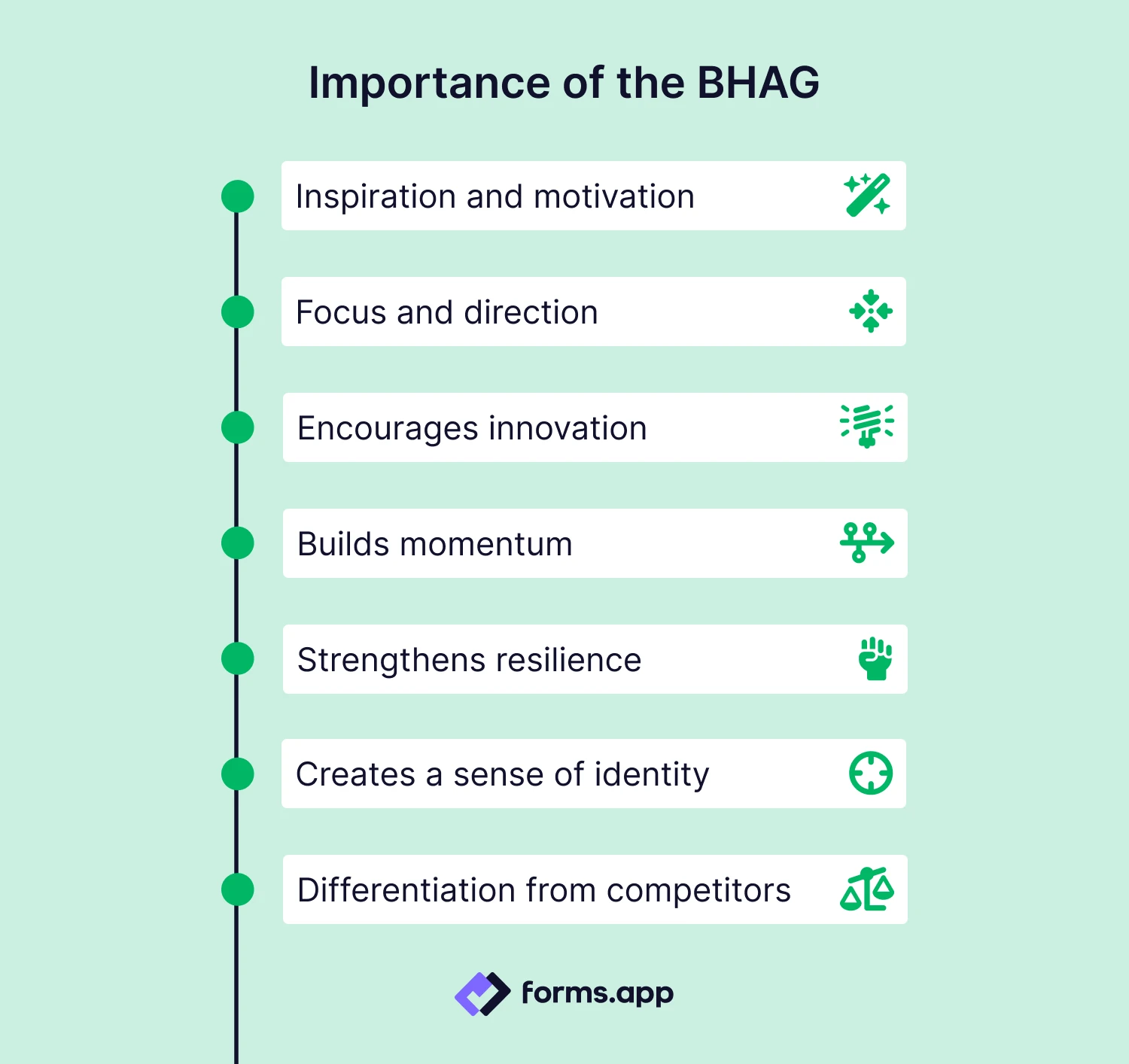
Advantages of the BHAG
One of the most significant aspects of BHAG is that it inspires individuals to work towards and achieve their goals by allowing them to think outside the box. Focusing on visionary, long-term goals, BHAG has a number of important aspects that stimulate innovation and creativity. Here are some key importance of BHAG that we have tailored for you:
1. Inspiration and motivation
People are more likely to invest energy into something that feels transformative. A good BHAG inspires people by presenting an ambitious vision. The excitement and a sense of purpose motivate people and push them to work beyond expectations.
2. Focus and direction
BHAG provides focus by setting a clear target and helping businesses prioritize efforts and resources on what’s important. A well-crafted BHAG narrows the focus, and it plays as a guide for organizations in the decision-making process.
3. Encourages innovation
As a bold strategy, BHAG allows businesses to think outside the box when finding creative solutions to problems. It encourages individuals to challenge conventional thinking, take risks, and learn from experience when working towards the audacious target.
4. Builds momentum
As with most other success stories, progress towards a BHAG starts with small achievements. Over time, these milestones accumulate and bring you closer to the big target. The nature of BHAG helps you break down the steps of achievement to strengthen the long-term goal.
5. Strengthens resilience
Unlike many other strategies, BHAG requires a long-term commitment, which instills a sense of resilience. When there are obstacles along the way, working towards something you believe in makes it easier to tackle those problems and increases perseverance. This also helps to adapt to certain situations and learn from failures.
6. Creates a sense of identity
A BHAG can help shape a business’s identity by clarifying the targets and what they stand for. It can create a strong sense of purpose that can go beyond profit-making. When a business positions itself clearly, the customers can easily resonate with that vision.
7. Differentiation from competitors
If you have a well-crafted BHAG, your business can be set apart from its competitors. In a competitive market, your organization can strive towards great achievements and can stand out amongst other businesses with its boldness and ambition.
4 BHAG types
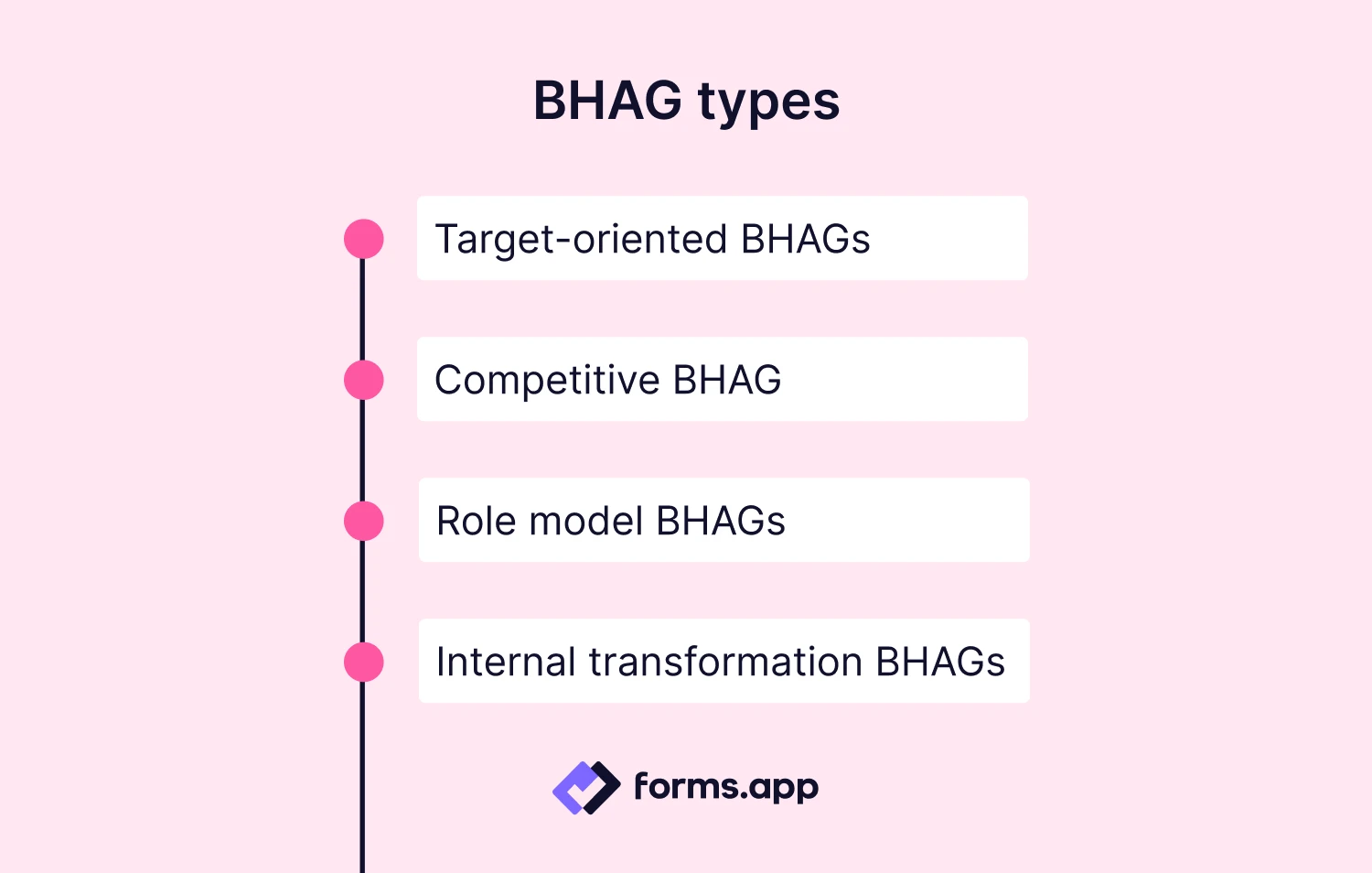
4 Types of the BHAG
As we have mentioned above, BHAGs are popularly long-term, ambitious goals. A BHAG can pull a team together and push the boundaries to achieve something that could only be possible by teamwork. There are 4 types of BHAGs consisting of Target-Oriented BHAGs, Competitive BHAGs, Role-Model BHAGs, and Internal Transformation BHAGs.
1. Target-oriented BHAGs
This is the most common BHAG type that focuses on achieving the goal within a given time frame. These goals typically include measurable quantitative milestones, such as revenue targets, but they can also be qualitative. One of the best BHAG examples of this type is the goal of landing a man on the Moon by a specific date. It was an ambitious, target-focused qualitative BHAG.
How to set target-oriented BHAGs: Choose a long-term goal that can motivate your team. Make sure the goal is broad and addresses the overall mission of the organization.
Potential risks and how to avoid them: Ensure the target is inspiring and also requires effort to achieve. If the goals are revenue-focused, make sure they resonate with all team members, not just the sales department.
2. Competitive BHAG
Competitive BHAGs are about uniting your team against a large competitor. This type of BHAG can energize your team and create a sense of urgency to outperform rivals. This would also advance your performance. For example, Nike’s initial goal in the ‘60s about crushing Adidas was a strong competitive BHAG.
- How to set competitive BHAGs: Identify a competitor that your business has been battling for a long time. Decide whether your goal is to win over them in a particular area or across the board, which will rally the competitive spirit of the team.
- Potential risks and how to avoid them: Make sure the mission statements and everything else are made clear regarding the competition, and there is no ambiguity that would cause confusion in the team. This is even more crucial, especially when you are the underdog in the market.
3. Role model BHAGs
As a business organization, you do not always have to be authentic or innovative regarding having a successful BHAG. You can also replicate a role model, BHAG, which you think is suitable for your mission, either within the same industry or a different one, to guide you to success. A good example is that Stanford University informally calls itself the “Harvard of the West” to emulate Harvard’s reputation.
- How to set role model BHAGs: Choose a business with a strong success story you admire. You can use that as a model for your goal, setting a BHAG that adapts to your organization’s needs.
- Potential risks and how to avoid them: Make sure you understand the details and specific factors that contributed to your role model’s success. Try not to replicate everything, but only the key elements that will help your organization the best. This model is more suitable for start-ups or scale-up companies that are not completely established.
4. Internal transformation BHAGs
As the name suggests, the internal transformation model focuses on significant changes to your business model. When a company needs to pivot its operations, a BHAG can encapsulate the goal of that transformation and the target achievement. For example, Netflix has transformed from mailing DVDs to becoming the world's most successful online streaming service.
- How to set internal transformation BHAG: Identify your organization's needs, such as market change or restructuring business strategy. The BHAG will represent the outcomes you hope to achieve from this internal transformation.
- Potential risks and how to avoid them: Internal transformation can be a big challenge, so make sure it is the best decision and most beneficial for your business. Frequent changes can demoralize your team and make things harder to adjust. So, ensure a good change management process to facilitate the smooth transition.
4 Successful BHAGs of well-known brands
Before you take a step further with drafting your own BHAG, make sure to have a look at some of the most successful BHAGs of all time. A true BHAG has a strong vision and motto. This will help you navigate your own BHAG plan, define a mission, and also motivate and inspire you along the way. Here is a list of some popular BHAGs of well-known brands.
1. Google
Google came with a strong BHAG, stating, “Organise the world’s information and make it universally accessible and useful.” It was an impactful, bold BHAG that revolutionized how we access knowledge. Google has been rocking the market since 1998.
2. Amazon
With “Become the world’s most customer-centric company,” Amazon has become the number one online purchasing market, offering a seamless experience and innovation in e-commerce. Today, Amazon is a global leader in retail, consistently prioritizing customer satisfaction.
3. Microsoft
Envisioning a world where personal computers were accessible to everyone with a simple BHAG, “A computer on every desk and in every home,” in the mid-70s, Microsoft has been ruling the computer world for over 30 years.
4. NASA
Announced by President John F. Kennedy, “Land a man on the moon and return him safely to Earth” drove NASA’s efforts in the Space Race and was realized in 1969 when Neil Armstrong became the first person to walk on the moon, which was the greatest scientific achievement in history.
7 Tips for a better BHAG
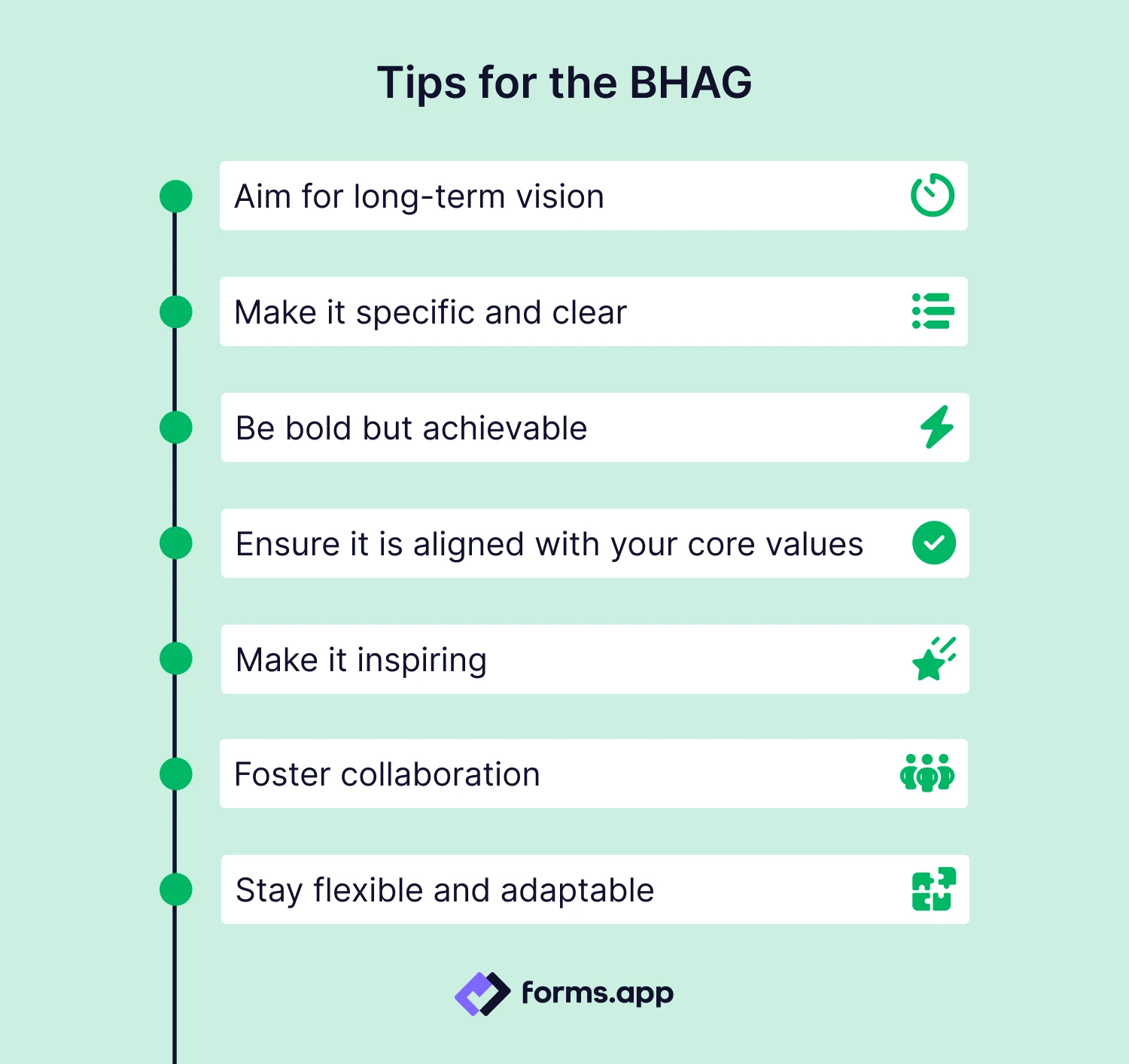
BHAG tips
Crafting an effective BHAG for the success of your business needs to be bold, motivating, and clear. Here are seven tips for a better BHAG:
1. Aim for long-term vision: If you want a long-term, successful BHAG, do not hesitate to aim for a big target almost out of reach. A great BHAG should look at least ten years into the future. The goal should be challenging but also doable and should require sustained effort over time.
2. Make it specific and clear: A good BHAG should be defined clearly in detail to avoid any confusion that it may cause. It needs to be specific enough for people to understand exactly what your organization means to achieve. You should include concrete milestones wherever possible. For instance, instead of “Improve our market presence”, say, “Capture 20% market share by 2034”.
3. Be bold but achievable: BHAG does not have the word ‘audacious’ for nothing. Your BHAG should push boundaries, surpass limits, and challenge the status quo. This means getting out of your comfort zone and feeling uncomfortable while working on a possible but demanding goal.
4. Ensure it is aligned with your core values: Remember what matters when you create your BHAG. Stay true to your organizational values, and make sure your BHAG resonates with them as well.
5. Make it inspiring: Your BHAG should inspire and motivate you and others, evoke excitement, and bring a sense of purpose. It is about your target, the path you follow, and what you experience towards your goal. Choose a goal that motivates everyone.
6. Foster collaboration: You need to get everyone in your team involved in your BHAG. This will help to stay on track. You should interact with your team regularly, have a shared vision, and make sure everyone understands their role.
7. Stay flexible and adaptable: As with everything else, things can change rapidly, or something else can happen out of the ordinary. In such situations, you should be able to adapt and make necessary adjustments. You need to refine and adjust your BHAG regularly to remain relevant.
Frequently asked questions about the BHAG
So far, we have dug into the definition, importance, and all the popular examples to give you a clear vision of what a good BHAG looks like. Below are some frequently asked questions that could help clarify any additional points.
BHAG stands for Big Hairy Audacious Goal.
To write a personal BHAG, you need to set a bold, long-term goal that excites you, aligns with your values, and challenges you to grow.
Jim Collins and Jerry I. Porras first introduced the concept of BHAG in their book Built to Last: Successful Habits of Visionary Companies’ in 1994.
Wrapping it up
Having a vision and a clear, audacious goal and building your way towards it takes courage and perseverance. Businesses with a good BHAG are set to succeed with consistency and the effort and energy they bring to each milestone. BHAG makes each business unique, strong, and different from others.
In this article, we have covered BHAG’s meaning, importance, and types of BHAGs with examples, examples of successful BHAGs, and tips for a better BHAG to help you create your own BHAG for your achievements. Crafting a good BHAG might be a hard task, but when you do, it determines the future of your business.
Elif enjoys sharing her expertise through helpful guidelines and tips about marketing and business planning. She is also a linguist who has a deep interest in maps, history, culture, and languages.

